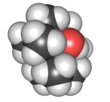| |||
| Names | |||
|---|---|---|---|
| Preferred IUPAC name 3-tert-Butyl-2,2,4,4-tetramethylpentan-3-ol | |||
| Identifiers | |||
| CAS Number | |||
| 3D model (JSmol) | |||
| ChemSpider | |||
| PubChem CID | |||
| UNII | |||
| CompTox Dashboard (EPA) | |||
InChI
| |||
SMILES
| |||
| Properties | |||
| Chemical formula | C13H28O | ||
| Molar mass | 200.366 g·mol | ||
| Except where otherwise noted, data are given for materials in their standard state (at 25 °C , 100 kPa).
| |||
2,2,4,4-Tetramethyl-3-t-butyl-pentane-3-ol or tri-tert-butylcarbinol is an organic compound with formula C13H28O, ((H3C)3C)3COH, or Bu3COH. It is an alcohol that can be viewed as a structural analog of a tridecane isomer (2,2,4,4-tetramethyl-3-t-butylpentane) where the central hydrogen has been replaced by a hydroxyl group -OH.
Tri-tert-butylcarbinol is arguably the most sterically hindered alcohol that has been prepared to date. In contrast to all other known alcohols, the infrared spectrum of the liquid does not exhibit a broad OH absorption associated with intermolecular hydrogen bonding, making it interesting for research in spectroscopy. The bulky tert-butyl groups (H3C)3C- groups attached to the central carbon prevent the formation of a O–H---O hydrogen bond with another molecule, an intermolecular interaction typical of alcohols.
Another structural analog, in which the COH group is replaced by N, is tri-tert-butylamine, a molecule predicted to be stable but has never been prepared.
Tri-tert-butylcarbinol was first prepared in poor yield using Barbier-type conditions by coupling hexamethylacetone with t-butyl chloride in the presence of sodium sand (5.1 to 8.5% yield), presumably via the organosodium species. Later on, it was shown that under carefully selected conditions, the compound could be prepared in high yield (81%) by addition of tert-butyllithium to hexamethylacetone.
References
- Z. Malarski (1974). "Solid rotator phases in 2,2,4,4-tetramethyl-3-tert-butyl-3-pentanol (t-Bu3COH)". Mol. Cryst. Liq. Cryst. 25 (3–4): 259–272. doi:10.1080/15421407408082805.
- Irena Majerza; Ireneusz Natkaniec (2006). "Experimental and theoretical IR, R, and INS spectra of 2,2,4,4-tetramethyl-3-t-butyl-pentane-3-ol". J. Mol. Struct. 788 (1–3): 93–101. Bibcode:2006JMoSt.788...93M. doi:10.1016/j.molstruc.2005.11.022.
- Bartlett, Paul D.; Schneider, Abraham (1945). "The Synthesis of Tri-t-butylcarbinol and Other Highly Branched Alcohols by Means of Sodium". Journal of the American Chemical Society. 67 (1): 141–144. doi:10.1021/ja01217a049. ISSN 0002-7863.
- Bartlett, Paul D.; Lefferts, Edwin B. (1955). "Highly Branched Molecules. III. The Preparation of Tri-t-butylcarbinol by Means of t-Butyllithium". Journal of the American Chemical Society. 77 (10): 2804–2805. doi:10.1021/ja01615a040. ISSN 0002-7863.

